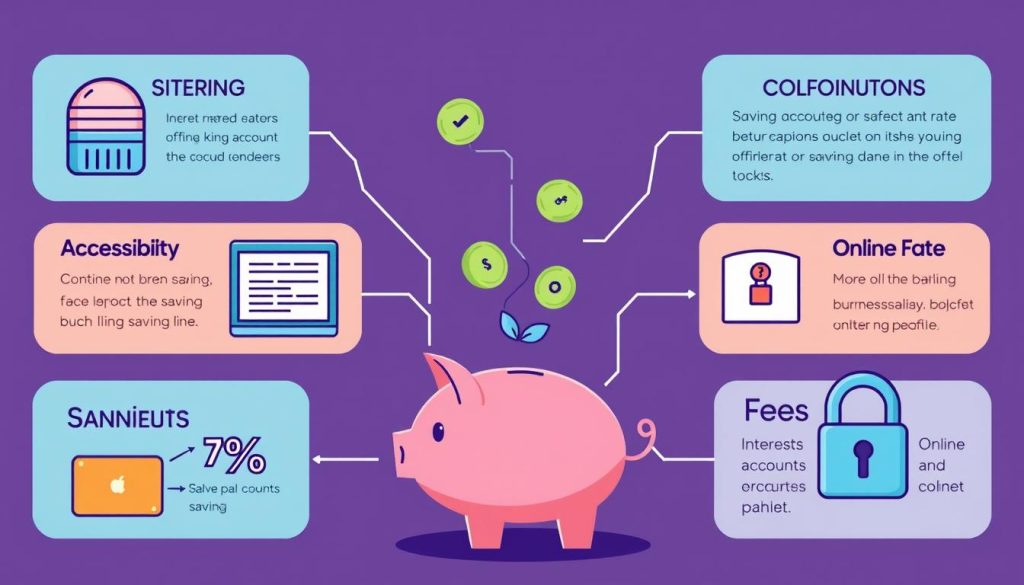Savings accounts are a safe spot to keep your money. They offer many benefits that help you reach your financial goals. This guide is for financial experts and anyone wanting to improve their money management. It covers the types of savings accounts, their role today, important things to think about, and ways to save more12.
In today’s world, savings accounts are key for keeping your money safe, earning interest, and building an emergency fund. You’ll learn about traditional and high-yield options, and money market accounts. This guide helps you decide where to put your savings1.
Digital banking has changed how we handle our money. It offers tools for checking balances in real-time, automating tasks, and making things easier to access2. We’ll talk about the challenges savers face, like inflation and changing interest rates. This will help you get the most from your savings2.
This guide is for anyone saving for a goal or planning for the future. You’ll find strategies and tips to boost your savings. Learn how to automate savings and use laddering to meet your financial goals12.
Key Takeaways
- Savings accounts offer a safe and accessible place to store your money, with varying interest rates and features.
- High-yield savings accounts can provide much higher returns compared to traditional savings accounts, with average rates around 5% APY3.
- Digital banking has revolutionized the management of savings accounts, offering real-time access and automation tools2.
- Savings accounts play a crucial role in building emergency funds and achieving financial goals, whether short-term or long-term.
- Strategies like automating contributions and laddering CDs can help you maximize your savings potential.
- https://criminalinjurylaw.com/injury-settlements-fraud-the-dark-side-of-personal-injury-lawsuits-6/
Understanding Savings Accounts
Definition and Purpose
A savings account is a type of account at a bank or credit union that earns interest. It’s meant to be a safe place to keep your money and watch it grow over time4. These accounts pay you back a part of your money as interest.
Types of Savings Accounts
There are many kinds of savings accounts, each with its own benefits. Traditional savings accounts are a solid choice for keeping your cash safe. High-yield savings accounts, often found online, offer higher interest rates4. Money market accounts mix savings and checking features, possibly giving you higher interest5. Certificates of deposit (CDs) offer higher rates but require you to keep your money locked in for a set time6.
When picking a savings account, think about the interest rate, balance requirements, and any fees4. Some accounts limit how often you can withdraw or transfer money, while others offer more flexibility5.
Your savings are usually insured by the FDIC or NCUA up to $250,000 per account5. This means your money is extra safe and secure.
| Savings Account Type | Key Features | Interest Rates |
|---|---|---|
| Traditional Savings | Basic savings account with minimal features | 0.01% to 0.50% APY |
| High-Yield Savings | Offers higher interest rates, often found at online banks | 0.50% to 4.50% APY |
| Money Market Accounts | Combines features of savings and checking accounts | 0.75% to 2.00% APY |
| Certificates of Deposit (CDs) | Fixed-term deposit accounts with higher rates | 1.00% to 5.00% APY |
Knowing about the different savings accounts can help you pick the right one for your needs4. Whether you want to save for emergencies, a big purchase, or just earn interest, a savings account is a great choice645.
Benefits of Having a Savings Account
Having a savings account brings many benefits for your financial health. It keeps your money safe with FDIC insurance and lets you earn interest. This makes it a key part of managing your money well7.
Safety and Security
A savings account keeps your money safe and secure. With FDIC insurance, your deposits are protected up to $250,00078. This means your hard-earned cash is safe, even when the economy is shaky. It lets you focus on growing your financial strength.
Earning Interest
Your savings account can earn interest, helping your money grow over time. Interest rates change, but compound interest makes your money work for you78. This can slowly but surely increase your savings.
Emergency Fund
Having a savings account for emergencies is key to your financial plan. It helps you save for unexpected costs like medical bills or car repairs7. This way, you can handle financial surprises better and stay financially strong.
“A savings account can be a powerful tool in building your financial security and resilience. It provides a safe haven for your money while allowing it to grow over time through the power of compound interest.”
The Modern Role of Savings Accounts
In today’s world, savings accounts have changed a lot. Thanks to online banking and mobile banking, they’re easier to use and get to. Now, you can handle your savings from anywhere, set up automatic transfers, and use smart budgeting tools9. During tough times like the COVID-19 pandemic, savings accounts are key for keeping money safe and staying financially stable9.
Digital Banking
Digital tools have changed how we deal with savings accounts. You can check your balance, deposit money, and watch your savings grow anytime, anywhere, on your phone or computer9. This makes savings accounts a crucial part of managing your money.
Economic Uncertainties
When the economy is shaky, like during the global health crisis, savings accounts are more important than ever for financial stability9. With rates around 0.43% for savings accounts9, banks have started offering high-yield savings products with rates up to 5.00% or more10. These new savings products help you grow your money safely during uncertain times.
| Account Type | Average Interest Rate |
|---|---|
| Savings Accounts | 0.43%9 |
| Money Market Accounts | 0.62%9 |
| 1-Year CDs | 1.76%9 |
“Savings accounts have become an increasingly important haven for preserving capital and maintaining financial stability during economic uncertainties.”
The role of savings accounts keeps growing. They offer convenience, security, and chances for your money to grow. With digital banking and new savings products, they’re key for reaching your financial goals, no matter the economic conditions910.
Considerations and Challenges
Savings accounts have many benefits, but they also come with important things to think about. One big worry is how inflation affects your savings’ value11. Even with interest rates over 5% on some accounts, the interest might not keep up with living costs going up11.
Also, interest rates on savings can change often, based on the market and economy12. It’s key to know about any withdrawal restrictions or fees your account has. These can affect how you use your money12.
Inflation
Inflation can lower the value of your savings, as interest might not match the cost of living increases11. This is a big challenge for people wanting to grow their money and reach their financial planning goals.
Interest Rate Variability
Interest rates on savings can change a lot, due to market ups and downs12. It’s crucial to keep up with interest rates and be ready for changes that might affect your savings.
Knowing these things can help you make better choices with your savings. Being alert and active can help you get the most from your savings account. It can also lessen the downsides.

| Consideration | Description |
|---|---|
| Inflation | Erosion of purchasing power due to rising costs |
| Interest Rate Variability | Fluctuations in savings account yields based on market conditions |
| Withdrawal Restrictions | Limitations on the frequency or amount of withdrawals |
| Fees | Account maintenance, transaction, or other charges that can reduce earnings |
“Staying vigilant and proactive can help you maximize the benefits of your savings account while mitigating the potential drawbacks.”
savings accounts and Financial Goals
Savings accounts are key for reaching both short-term and long-term financial goals. For short-term goals, like saving for an emergency fund or a vacation, they offer a safe spot to keep your money13. For long-term goals, such as saving for a down payment or retirement, they help as a starting point, alongside other investment strategies13.
Short-Term Goals
Short-term goals are those you can reach in a year or less13. Examples include saving for emergencies, vacations, or unexpected bills. Using a savings account for these goals helps you stay disciplined, track your progress, and have money ready when you need it13.
Long-Term Goals
Long-term goals take more than five years to achieve13. These might be saving for a home down payment, a child’s education, or a strong retirement fund. Regularly adding to a savings account for these goals helps you move closer to a secure financial future13.
| Goal Type | Time Frame | Example Goals |
|---|---|---|
| Short-Term | 1 year or less | Emergency fund, vacation savings |
| Long-Term | 5 years or more | Down payment, retirement, education |
Linking your savings account to specific goals helps you stay disciplined, track your progress, and aim for a stable future13. Whether it’s for a short-term emergency or a long-term goal, a well-managed savings account is a key part of your financial planning strategy13.
“Time in the market is emphasized over timing the market for investment success.”14
Choosing the Right Savings Account
Choosing the right savings account is key to growing and accessing your money easily. You should look at interest rates, minimum balances, fees, and how easy it is to use. The right account can greatly improve your financial health15.
Factors to Consider
Interest rates, or Annual Percentage Yield (APY), are crucial when picking a savings account. Online banks usually have higher APYs because they don’t have the costs of physical branches15. Some savings accounts offer APYs over 5%, which is much higher than the average of 0.45% from traditional accounts16.
It’s important to check the minimum balance and monthly fees of a savings account. Many accounts have fees but you can avoid them by keeping a certain balance, setting up automatic transfers, or linking to a checking account at the same bank15. Make sure to look at these details to avoid extra charges.
Think about how easy it is to use your savings account too. Traditional banks offer face-to-face service and more financial products but usually have lower APYs than online banks15. Neobanks or fintech options offer low or no fees, easy online and mobile access, and tools like automated savings and spending analysis15.
Comparing Account Features
When looking at different savings accounts, check their features and benefits. This includes FDIC insurance for extra security on your deposits17, and the bank’s reputation and stability.
It’s smart to compare APYs, fees, and special perks across different accounts. Look at options from traditional banks, online banks, or credit unions17. By carefully checking your options, you can pick the account that fits your financial goals and likes.

The key to picking the best savings account is to think about what you need and want, and stay updated on the latest trends and innovations. Making an informed choice can help you grow and access your savings better151716.
Maximizing Your Savings Account
To boost your savings, try strategies that increase your savings potential. Automate your savings by setting up regular transfers from your checking account. This makes saving easier and helps your savings grow.
Automating Contributions
Automatic transfers can change how you save. They make sure you save a part of your income without the chance to spend it. Consistent monthly savings are better than saving all at once18.
This method builds your savings and helps you stay disciplined. It makes reaching your savings goals easier.
Laddering Strategies
Using laddering strategies can also boost your savings. Invest in CDs with different due dates to use changing interest rates. High-yield savings accounts or CDs offer good interest rates19.
These strategies help you save more and make the most of your money. They make your savings plan strong and grow your savings over time.
For better savings, focus on financial discipline20 and diversified savings18. Automate your savings and use laddering to build a strong financial future.
“Automating your contributions can foster financial discipline and ensure consistent growth of your savings.”
Conclusion
Savings accounts are key to your financial journey. They let you store money safely, earn interest, and reach your financial goals. They offer safety and security and help you save for emergencies and big purchases. Savings accounts are crucial in today’s financial world.
With digital banking and economic changes, savings accounts keep proving their worth. They help you stay disciplined, resilient, and financially healthy21.
Learning about different savings accounts and how to use them can set you up for a strong financial future21. Even though traditional savings accounts have lower interest rates21, high-yield ones can give you much higher returns, over 4% or more22. By comparing accounts and finding the best rates, you can boost your savings.
Remember, savings accounts do more than just grow your wealth. They help you feel secure, disciplined, and at ease. By focusing on saving and using these accounts wisely, you can control your finances and secure your future.
FAQ
What is a savings account?
A savings account is a type of bank account that earns interest. It’s meant to be a safe place for your money to grow over time.
What are the different types of savings accounts?
There are several kinds of savings accounts. They include traditional savings, high-yield savings, money market accounts, and CDs. Each type offers unique benefits.
What are the key benefits of having a savings account?
Savings accounts offer safety and the chance to earn interest. They help you build an emergency fund. Money in FDIC-insured banks is insured up to 0,000, and you can watch your savings grow.
How has the role of savings accounts evolved in the digital age?
Now, savings accounts are easier to use thanks to online and mobile banking. You can manage your money from anywhere, set up automatic transfers, and use budgeting tools. They’re also a safe spot for your money during tough economic times.
What are some key considerations and challenges with savings accounts?
Things to think about include inflation’s effect on your savings and how interest rates change. You should also consider any fees or rules for withdrawals. Finding the right balance is key to getting the most from your savings.
How can a savings account help you achieve your financial goals?
Savings accounts are vital for reaching both short and long-term goals. They’re perfect for saving for emergencies or a vacation. For bigger goals like a down payment or retirement, they’re a solid foundation for your financial plan.
What factors should I consider when choosing a savings account?
Look at the interest rate, balance requirements, fees, and how easy it is to get to your money. Comparing different accounts at banks, online banks, or credit unions will help you pick the best one for you.
How can I maximize the potential of my savings account?
To get the most from your savings, try automating your savings. Set up regular transfers from your checking account. Also, consider laddering strategies, like CDs with different due dates. These methods can help you save more and make the most of interest rates.

